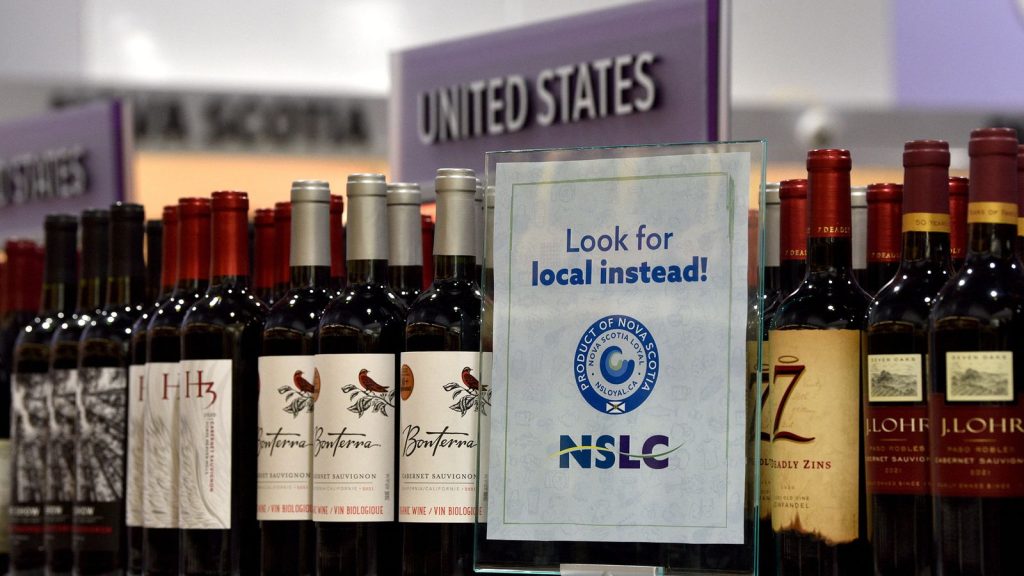Donald Trump has slapped a tariff on goods from China, with two more looming over Mexico and Canada. What are they and what do they mean for the UK?
The second-time president says he is imposing tariffs – taxes on goods imported into the US – arguing higher levies will help reduce illegal migration and the smuggling of the synthetic opioid fentanyl to the US.
On Saturday, the president confirmed he would subject Mexican and Canadian goods to the full 25% tariff – and imports from China to a 10% one.
The levies were expected to all take effect on Tuesday, with Mexico and Canada both announcing counter-tariffs of their own in response, but only China’s went through, with the others paused for a month.

A sign encouraging Canadian shoppers to ‘look for local instead’ in front of US alcohol at a store in Halifax, Nova Scotia, after Donald Trump targeted Canada with tariffs. Pic: Reuters
Both Mexican President Claudia Sheinbaum and Canadian Prime Minister Justin Trudeau announced the pauses, after calls with President Trump.
The leaders have promised extra troops at their borders with the US to combat illegal migration, as part of a range of measures to try to avoid Mr Trump’s trade war.
But Mr Trump has also threatened to go further, and target other nations, saying tariffs on the European Union would be implemented “pretty soon”.
Read more on Trump’s tariffs:
What’s going on – and what does it all mean?
Please use Chrome browser for a more accessible video player

1:14
China’s plan for responding to Trump’s trade war
Will Trump target UK with tariffs?
No new US tariffs have been announced on the UK, though when quizzed about it by the BBC, Mr Trump said the UK was “out of line”.
“But I’m sure that one… I think that one can be worked out,” he added.
Mr Trump is largely concerned with trade deficits – when you import more goods from another country than you send there in return.
UK ministers have previously suggested the UK could avoid tariffs as the US does not have a trade deficit with Britain.
Ed Conway analysis:
How UK could avoid Trump’s trade war by accident
Please use Chrome browser for a more accessible video player

1:29
How Trump’s tariffs will affect Britain
And despite his threat, Mr Trump also had positive words for the UK when he said discussions with Prime Minister Sir Keir Starmer had “been very nice”.
“We’ve had a couple of meetings. We’ve had numerous phone calls. We’re getting along very well,” he said.
At the weekend, when asked by Sky News’ political editor Beth Rigby if he is worried, Sir Keir said it was “early days” and added: “I think what’s really important is open and strong trading relations and that has been the basis of my discussions with President Trump.”

Donald Trump and Keir Starmer. Pic: Reuters
Why tariffs could cost you – even if Trump spares UK
Even if no tariffs are put on UK exports, consumers will be impacted by a trade war.
Economists widely believe that tariffs will raise costs in the US, sparking a wave of inflation that will keep interest rates higher for longer. The US central bank, the Federal Reserve, is mandated to act to bring inflation down.
More expensive borrowing and costlier goods and services could bring about an economic downturn in the US, the world’s largest economy.
Global movements could hit the UK.
Forecasts from the National Institute of Economic and Social Research (NIESR) predict lower UK economic growth due to higher global interest rates.
It estimates UK GDP (a measure of everything produced in the economy) could be between 2.5% and 3% lower over five years and 0.7% lower this year.
Read more:
Why has Trump targeted Mexico and Canada?
Canada and Mexico hit back with retaliatory tariffs
Some economists argue, though, that the UK might not be hurt too badly even if President Trump did impose tariffs on British goods.
The UK doesn’t send a lot of things to the US, instead exporting banking and consulting services which do not tend to be subject to tariffs.
However, the Centre for Inclusive Trade Policy thinktank said a 20% across-the-board tariff, impacting the UK, could lead to a £22bn reduction in exports from the UK to the US, with the hardest-hit sectors including fishing and mining.
The British government is keen to avoid any risk to its plans for economic growth – which already face challenges.
Please use Chrome browser for a more accessible video player

0:41
Starmer: Growth is number one priority
What if Trump persists with tariffs after pause?
There’s still a chance President Trump will continue with his plans for tariffs on Canada and Mexico, despite the pause announced this week.
If that happens, Canadian energy, including oil, natural gas and electricity, will be taxed at a 10% rate, as well as the 25% tariff on Mexican and Canadian goods.
Although the Trump administration said the 10% tariff would boost domestic energy production, there would also likely be wide-ranging negative consequences for the US consumer if it was introduced.
Economists argue supply chains will be disrupted and businesses will suffer increased costs – leading to an overall rise in prices.
Both Mexico and Canada rely heavily on their imports and exports, which make up around 70% of their Gross Domestic Products (GDPs), putting them at even greater risk from the new tariffs.
China only relies on trade for 37% of its economy, having made a concerted effort to ramp up domestic production, making it relatively less vulnerable.
Below we look at where US consumers will feel the biggest impact, if tariffs are enforced.
Please use Chrome browser for a more accessible video player

2:46
Tariffs to focus on Mexico and Canada
Avocados – and other fruit and veg
The US imports between half and 60% of its fresh produce from Mexico – and 80% of its avocados, according to figures from the US Department of Agriculture.
Canada also supplies a lot of the US’s fruit and vegetables, which are mainly grown in greenhouses on the other side of the US border.
This means that increased tariffs would quickly be passed on to consumers in the form of higher prices.
The US still grows a considerable amount of its own produce, however, so the changes could boost domestic production.
But economists warn an overreliance on domestic goods will see those suppliers increase their prices too.

Avocados from Mexico at a store in the US. Pic: Reuters
Petrol and oil prices
Oil and gas prices are likely to be impacted – as Canada provides around 60% of US crude oil imports and Mexico roughly 10%.
According to the US Energy Information Administration, the US received around 4.6 million barrels of oil a day from Canada last year – and 563,000 from Mexico.
Most US oil refineries are designed specifically to process Canadian products, which would make changing supply sources complex and costly.
Oil tariffs could see an increase in fuel prices of up to 50 cents (40p) a gallon, economists have predicted.
Please use Chrome browser for a more accessible video player

15:13
Trump 100: Why is he blaming diversity push for the Washington DC plane crash?
Cars and vehicle parts
The US car industry is a delicate mix of foreign and domestic manufacturers.
The supply chain is so complex that car parts and half-finished vehicles can sometimes cross the US-Mexico border several times before they are ready for the showroom.
If this continues, the parts would be taxed every time they move countries, which would lead to an even bigger increase in prices.
To mitigate this, General Motors has said it will try to rush through Mexican and Canadian exports – while brainstorming how to relocate manufacturing to the US.
Electronic goods
When Mr Trump imposed a 50% tariff on imported washing machines during his first term in 2018, prices suffered for years afterwards.
China produces a lot of the world’s consumer electronics – and smartphones and computers specifically – so the 10% tariff could have a similar effect on those devices.
The Biden administration tried to legislate to promote domestic production of semiconductors (microchips needed for all smart devices) – but for now, the US is still heavily reliant on China for its personal electronics.
This will mean an increase in prices for consumers unless tech companies can relocate their operations away from Beijing.
Boost for the steel industry
The sector that could feel the most benefit from the Trump tariffs is the steel and aluminium industry.
It has long been lobbying the government to put tariffs on foreign suppliers – claiming they are dominating the market and leaving US factories without enough business and at risk of closure.
Steel imports increasing in price would promote domestic production – and possibly save some of the plants.
But when Mr Trump increased steel tariffs during his first term, prices also increased – which business leaders said forced them to pass on costs and left them struggling to complete construction projects on budget.
Overall inflation
An increase in the prices of all these goods would inevitably lead to widespread overall inflation.
According to analysis by Capital Economics, the Canadian and Mexican tariffs would put inflation above 3% – which is much higher than the Federal Reserve’s target of 2% – and the Chinese levies would see it rise even further.








